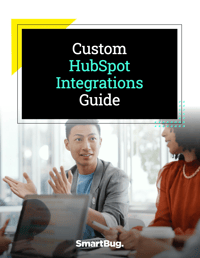
Mastering Data Integration: Best Practices for Aligning Metrics Between HubSpot and Other Analytics Solutions
December 13, 2023
By Brent Worley
Data integration enables incredible storytelling and precise audience targeting. When wielded well, this can help smart companies win more business.
There’s a big caveat, though. Our industry is information-heavy, which makes understanding and using our data a challenge. Aligning key metrics across different platforms properly can be the key to benefiting from our data—but doing so can feel like a complex puzzle.
It doesn’t have to be. Ready for your first step toward data integration mastery? Read on.
Let’s Start with Clear Definitions: What Is Data Integration?
Data integration is the process of combining data from different sources to make sure they work together in support of lead generation, personalization, business strategy, or any other data-driven mission for a forward-thinking company.
If you’re a CMO, you’re constantly flooded by data streams from myriad channels. You’re keeping track of social media analytics, email campaign results, CRM systems, and website traffic statistics. Just imagine trying to make sense of your LinkedIn metrics, your Google Analytics data, and your sales data from HubSpot. Unless you love squinting at densely numbered spreadsheets, you’re not going to have a great time.
Data integration experts leverage technical know-how and business smarts to funnel disparate data streams to you in the most helpful, efficient way possible. This yields a lengthy list of intriguing benefits.
Four Compelling Reasons to Invest in Data Integration ASAP
Freeing up your time from sifting through various data sources manually may feel like enough of a value-add—but here are four more reasons to consider data integration:
- Data integration supports accurate, consistent reporting.
Integrating your data well results in trusted, genuinely helpful information at your fingertips. With accurate data reports, you’ll be better equipped to show the value of your marketing efforts. You’ll also be better poised to launch strategic, personalized campaigns.
Imagine the alternative: pouring resources into marketing strategies that don’t yield results, all because of misaligned metrics. Data integration helps in avoiding these costly missteps, ensuring that every dollar spent is a dollar well-invested.
- Data integration fuels efficiency.
Manually transferring and reconciling data between systems takes a lot of time—time you could better spend on more creative or value-adding tasks. Data integration automates these processes, freeing up precious time for your team to focus on what they do best: strategizing and creating.
Even more, if you’re in a situation where time is of the essence, real-time access to integrated, organized, accessible data means you can make swift and strategic decisions.
- Data integration democratizes data.
Not everyone is a data analyst or a coder. They shouldn’t have to be! By making data more user-friendly, anyone can better understand campaign performance and customer interactions. This fuels collaboration and empowers every team member to make great decisions.
- Data integration links marketing to revenue.
If you can tie your marketing efforts directly to revenue generation, you can unlock more resources. You can showcase the impact of your team’s work with confidence. You can protect your colleagues, and you can secure more funding for your next projects.
Obstacles Standing Between You and the Benefits of Data Integration
So far, so good. If you’re anything like us, you’re all in. You want to get started with data integration yesterday. Which begs the question: Why aren’t more people benefiting from this clear business value add?
High-quality data integration can be difficult. It’s not something you can decide to do, jump in, and accomplish at the drop of a hat. CMOs interested in benefiting from data integration may realize that they’re up against:
- Strongly siloed data
- Inconsistent data formats
- Real-time data access delays
- Limited control over tech platforms
- Resource scarcity constraining capabilities
- Complex data migration paths
Fortunately, we’re here to help. We’re not new to the data integration game—and today, we’re spilling a few potential game changers that can help you overcome these obstacles and benefit from integrated, accessible, and aligned metrics.
Practical Tips for Mastering Data Integration
Whether you’re investing in data integration for the first time or you’re familiar with the craft, these tricks of the trade should keep you moving in the right direction:
- Start with a clear strategy: Begin your journey with clearly defined objectives and a strong sense of how data integration will help you achieve your goals.
- Schedule recurring audits: Make it clear up front that you’re going to review your data processes on a regular basis to ensure that you’re always aligned with your objectives. Use these audits to identify and correct any inefficiencies or discrepancies.
- Choose the right tools: Select data analytics tools that integrate seamlessly with your existing tech. (For example, we like Databox as an analytics platform that works very well with HubSpot.) Look for platforms that provide intuitive reports and easy-to-read visuals, and are set up to scale with your business.
- Start small: Smaller than you think! You want your beginning set of metrics to be ultra-manageable. This will help you avoid getting overwhelmed and ensure the quality of your integration. You can expand your efforts as your comfort increases.
- Be aware of data storage costs: Data can cost quite a bit of money to store, especially at a large volume. Know these costs and plan accordingly. Simultaneously, you can optimize your data storage by purging or archiving data that you no longer need.
- Realize and resolve your data discrepancies: Develop a way to identify and reconcile any differences between data that you’re bringing in from different systems. This should include regular validation of your data to ensure that your information is as trustworthy as possible.
- Use your current resources first: As much as you can, leverage your existing tech, tools, and team before you consider upgrading. This will help you understand what you can already do and what you really need before you increase your data integration investment. Once you have this understanding, you’ll be better prepared to advocate for resources during budget discussions.
- Make your reports as actionable as possible: Create reports directly tied to your main goals and objectives. Ensure these reports lead to clear actions and are understandable for the people who will be reading them.
If you follow these tips, you’ll be on your way to practicing the craft of data integration well. (And, if you find you need a helping hand, we happen to have a team of data integration wizards you could call.)
Looking Forward to Aligned Metrics? Get Started with Data Integration Today!
Taking the time to break down data silos and replace them with a connected system that allows you to use your data while avoiding manual analysis will be well worth the effort. That comprehensive view of your data will fuel better storytelling, targeting, and segmentation ... which can ultimately win you more business.
Want to get your metrics aligned so you can amplify your impact? We’re here to help. Talk to our team today to learn about the best way to get started with custom data integrations.

About the author
Brent Worley is the Senior Director of Technical Services at SmartBug. Having started his career in large data software engineering, Brent has spent 14 years of his career designing, developing, and supporting best of breed solutions for his clients. He has expertise in all things data and identity recognition solutions. He currently lives in Conway, Arkansas with his wife and three daughters. Read more articles by Brent Worley.








-2.png?width=800&length=800&name=Blog%20header%20image%20(1)-2.png)